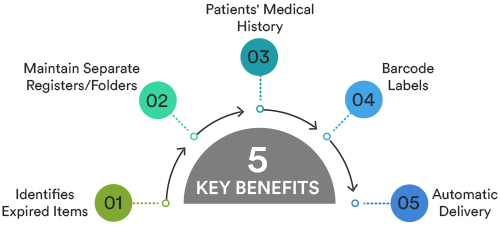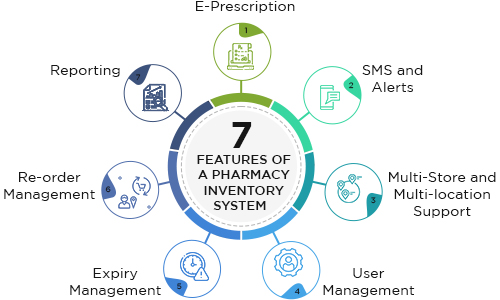Introduction:
A pharmacy inventory system or pharmacy management software stores data and systemizes and controls the pharmacy’s medication process. Healthcare technology is becoming advanced as the day passes to automate healthcare management.
An inventory system for pharmacy enables controlling medicine stock and selecting the right medicine by using pharmacy software systems. A pharmacist can utilize a pharmacy inventory system for improving pharmacy management services. In minor illnesses, patients prefer pharmacies over doctor’s visits, and a pharmacy management system can prescribe over-the-counter medicines. The automated inventory system pharmacy helps to manage medications better and automate the delivery of drugs.
Key benefits of a pharmacy software system

A pharmacy system offers pharmacists to operate their business more competently, including integrated care services. Pharmacy software vendors also make sales and profits more predictable and increase clientele. Let’s look at some benefits offered by a pharmacy management service.
- Identifies Expired Items: A pharmacy stock inventory system is a great way to manage pharmacy operations because it does not create bills for expired products. An inventory control system for the pharmacy notifies about expired medicines and helps the store owner systematically purchase new items.
- Maintain Separate Registers/Folders: A pharmacist can maintain a separate register containing details of all the drugs stored using a pharmacy folder. This keeps track of the composition of medicines and lets the user know the substitutes medicines, which can be life-saving in emergencies.
- Patients’ Medical History: A hospital pharmacy inventory management system can allow store owners and pharmacists to monitor the patient’s treatment as per the defined safety standards. Pharmacists can also access and review patients’ medical history using a standardized pharmacy inventory system.
- Barcode Labels: A barcode label is added to all products before distributing them to pharmacies and stores. Automated inventory system pharmacy promotes automated labeling of medication and print expiry dates of medicines using the latest pharmacy software for a pharmacy store. Also, the pharmacy inventory system helps to calculate the number of labels needed.
- Automatic Delivery: Pharmacy inventory systems have the interesting feature of automatically assigning orders to various distribution channels. This depends on the supply date of the items and the number of days needed to deliver the order to the customers through pharmacy inventory management software.
7 main features of a pharmacy inventory system

1. E-prescription
Prescriptions are usually difficult to read, which can confuse patients, which can be a source of error in dispensing the right medicine. E-prescriptions are an essential feature of a pharmacy inventory system that provides a user-friendly option for the patients and reduces errors.
Pharmacies can use the electronic prescription feature of prescription management software to manage refills. It also allows doctors to send the new refills directly into the pharmacy operating systems, allowing rapid dispensing of the medicines. E-prescription in a pharmacy database management system analyses data and removes all confusion in delivering the right prescription medicines.
2. SMS and alerts
Electronic pharmacy systems allow pharmacists to schedule text messages to be sent to patients notifying them before their prescriptions run out. With pharmacy inventory software, patients can then let the pharmacist know if they need a refill simply by responding to the message. It enhances practice management and also improves patient engagement. The status updates enable the pharmacists to keep in touch with the patients, which increases patient satisfaction.
3. Multi-store and multi-location support
This feature of pharmacy inventory software allows users to manage stores at multiple locations with a prescription management system. It enables the view of data and exchange electronic data on stock levels, sales, and returns from various stores in a single inventory management software for hospitals. A hospital inventory management software provides comprehensive reports for the entire chain of stores, which gives the user a comprehensive view of profit, loss, stock levels, etc.
4. User management
User management in pharmacy management solutions gives restricted access to various users. Access to multiple features of a pharmacy management software can be limited for different users to implement easy management. The authentication is divided into two types: administrator user and administrator authentication user.
The administrator user of a pharmacy management solution can manage the buying and selling of medicines, list the medicines, view the stock, and perform other tasks. The administrator authentication user of a pharmacy management software development can view all processes, including selling reports and transactions and manipulate the medicine list and medicine stock.
5. Expiry management
A mandatory feature for integrated pharmacy management solutions is expiry management. Pharmacies may suffer huge losses due to expired products. In any pharmacy, medicines are usually purchased in bulk with different MRP & expiry dates. As a result, pharmacists may lose track of the expiry dates of each medicine and mistakenly keep them on the shelves. This can be avoided by adding an expiry management feature in a pharmacy management system in healthcare. It can notify the near expiry medicines that the pharmacists can sell beforehand or return to the supplier.
6. Re-order management
Re-order points in a pharmacy management process refer to learning when to refill the stock, which product is better performing in the inventory, and so on. Such information in the pharmacy inventory management system workflow process can be helpful to pharmacists for remaining organized and informed. The pharmacists can decide the minimum & maximum stock level point. Then, the pharmacy inventory system software can indicate when the stock reaches the minimum level and when it is time to re-order the supplies. This feature of the inventory system in pharmacy also suggests the best buy option with nearest suppliers’ schemes and helps save more.
7. Reporting
Pharmacies deal with several patients daily and contain large volumes of health informatics stored in the pharmacy’s computerized inventory system. Data in a pharmacy inventory system can improve the business strategy or be needed during a certification or inspection process.
The reporting feature of the cloud-based pharmacy inventory system offers valuable insights into the operations in the pharmacy. It can be used to identify the patients who visit the pharmacy frequently for refills, which can further be applied to stock accordingly.
Conclusion
These features are a must-have while developing a pharmacy inventory management system for achieving high patient engagement and better revenue generation. OSP can help you with custom pharmacy management software development to effectively manage the stock and delivery of medicines. Our expert software developers can integrate all the necessary features and create an interoperable pharmacy inventory system.
OSP is a trusted software development company that delivers bespoke solutions as per your business needs. Connect with us to hire the best talents in the industry to build enterprise-grade software.

How can we help?
Fill out the short form below or call us at (888) 846-5382
Looking for software solutions to build your product?
Let's discuss your software solutions for your product in our free development acceleration call!
Get In Touch arrow_forwardDiscuss Your Project Handover with a team of expert Book a free consultation arrow_forward
About Author

Written by Riken Shah linkedin
Riken's work motto is to help healthcare providers use technological advancements to make healthcare easily accessible to all stakeholders, from providers to patients. Under his leadership and guidance, OSP Labs has successfully developed over 600 customized software solutions for 200+ healthcare clients across continents.

















